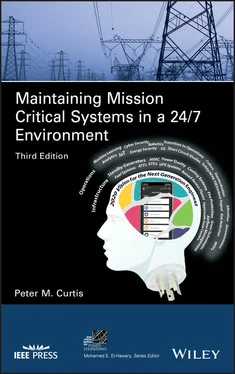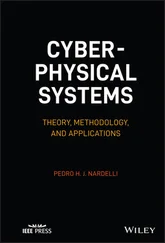Reliability analysis with PRA software provides a number of significant improvements over earlier, conventional reliability methods. The software incorporates reliability models to evaluate and calculate reliability, availability, unreliability, and unavailability. The results are compared to a cost analysis to help reach a decision about facility design. The process of evaluating reliability includes:
Analyzing any existing systems and calculating the reliability of the facility as it is currently configured.
Developing solutions that will increase the reliability of the facility.
Calculate the reliability with the solutions applied to the existing systems.
Evaluate the cost of applying the solutions.
3.6.1 Review of Reliability Terminology
Reliability (R)is the probability that a product or service will operate properly for a specified period of time under design operating conditions without failure.
The failure rate (λ)is defined as the probability that a failure per unit time occurs in the interval, given that no failure has occurred prior to the beginning of the interval.
For a constant failure rate λ, reliability as a function of time is:

Mean time between failures (MTBF), as its name implies, is the mean of the probability distribution function of failure. For a statistically large sample, it is the average time the equipment performed its intended function between failures. For the example of a constant failure rate:

Mean time to repair (MTTR)is the average time it takes to repair the failure and get the equipment back into service.
Availability (A):Availability is the long‐term average fraction of time that a component or system is in service and satisfactorily performing its intended function. This is also called s teady‐state availability . Availability is defined as the mean time between failures divided by the mean time between failures plus the mean time to repair:

High reliability means that there is a high probability of good performance in a given time interval. High availability is a function of failure frequency and repair times and is a more accurate indication of data center performance.
As more and more buildings are required to deliver service guarantees, management must decide what performance is required from the facility. Availability levels of 99.999% (5.25 minutes of downtime per year) allow virtually no facility downtime for maintenance or other planned or unplanned events. Therefore, moving toward high reliability is imperative. Since the 1980s, the overall percentage of downtime events caused by facilities has grown as computers become more reliable. And although this percentage remains small, the total availability is dramatically affected, because repair times for facility events are so high. A further analysis of downtime caused by facility failures indicates that utility outages have actually declined, primarily due to the installation of standby generators.
The most common response to these trends is reactive: that is, spending time and resources to repair the offender. If a utility goes down, install a generator. If a ground‐fault trips critical loads, redesign the distribution system. If a lightning strike burns power supplies, install a new lightning protection system. Such measures certainly make sense, as they address real risks in the data center. However, strategic planning can identify internal risks and provide a prioritized plan for reliability improvements. Planning and careful implementation will minimize disruptions while making the business case to fund these projects.
As technological advances find their way onto the data center’s raised floor, the facility will be impacted in unexpected ways. As equipment footprints shrink, free floor area is populated with more hardware. However, because the smaller equipment rejects the same amount of heat, power and cooling densities grow dramatically, and floor space for cooling equipment increases. The large footprint now required for reliable power without planned downtime – e.g., switchgear, generators, UPS modules, and batteries – also affects the planning and maintenance of data center facilities. Over the last two decades, the cost of the facility relative to the computer hardware it houses has not grown proportionately. Budget priorities that favor computer hardware over facilities improvement can lead to insufficient performance. The best way to ensure a balanced allocation of capital is to prepare a business analysis that includes costs associated with the risk of downtime. This cost depends on the consequences of an unplanned service outage in that facility and the probability that an outage will occur.
3.7 Design Considerations for the Mission Critical Data Center
In most mission critical facilities, the data center constitutes the critical load in the daily operations of a company or institution. The costs of hardware and software could run $3000‐ $4000 per square foot, often resulting in an investment of millions and millions of dollars depending on size and risk profile. In a data center of only 5000 square feet, you could be responsible for a $20 million capital investment, without even considering the cost of downtime. Combined, the cost of downtime and damage to equipment could be catastrophic.
Proper data center design and operations will protect the investment and minimize downtime. Early in the planning process, an array of experienced professionals must review all the factors that affect operations. This is no time to be “jack of all trades, master of none.” Here are basic steps critical to designing and developing a successful mission critical data center:
Basic Steps to Building a Critical Data Center
Determine the needs of the client and the reliability of the mission critical data center.
Develop the configuration for the hardware.
Calculate the air, water, and power requirements.
Determine your total space requirements and expected future space requirements.
Validate the specific site: Be sure that the site is well located and away from natural disasters and that electric, telecommunications, and water utilities can provide the high level of reliability your company requires.
Develop a layout after all parties agree.
Design the mission critical infrastructure to (N+1), (N+2), or higher redundancy level, depending on the risk profile and reliability requirements.
Once a design is agreed upon, prepare a budgetary estimate for the project, ensure a sufficient contingency is included in the budget at this point due to many unknowns and price escalations.
Have a competent consulting engineer prepare specifications and bid packages for equipment purchases and construction contracts. Use only vendors that are familiar with and experienced in the mission critical industry.
After bids are opened, select, and interview vendors and contractors. Take time to carefully choose the right vendors. Make sure you see their work; ask many questions; verify references and be sure that everybody is on the same page.
Читать дальше















